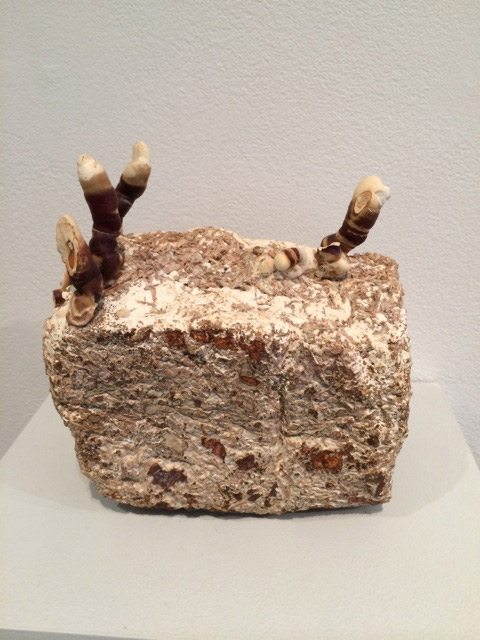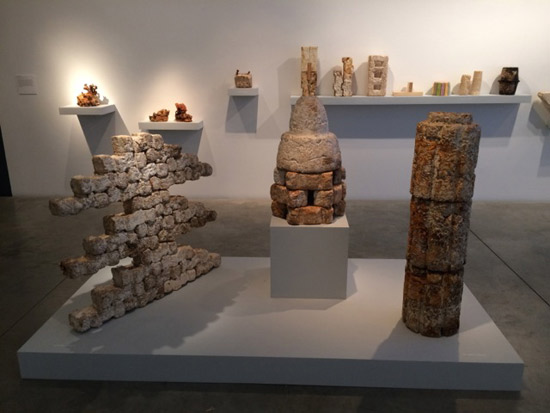Taking a much needed break from the madness of Armory Week unfolding several blocks north, I made a visit to a very interesting show at Parsons-New School for Design and received a breath of fresh and sensory stimulating air.
“Intimate Science”, curated by Parrish Art Museum associate curator Andrea Grover and organized by the Miller Gallery at Carnegie Mellon University, Pittsburgh, purports to highlight “The most recent manifestation of artists working at the intersection of art, science, and technology (demonstrating) a distinctly autodidactic, heuristic approach to understanding the physical and natural world," according to the exhibition information.
And it does not disappoint.
Some of the work in this exhibition is seemingly taken straight from the laboratory and presented to the viewer in a very different way than your average museum presentation. Test tubes, monitors and strange machines under glass vitrines give the show a very unorthodox, sci-fi feel, much to the benefit of the theme.
I witnessed the “bio-printing” experiments of Allison Kudla’s Growth Pattern, in which a living natural system takes on the form of a manufactured pattern through suspension in nutrient filled Petri dishes, to very interesting visual effect. Like some science experiments, failure is always a possibility, and unfortunately one of the displays was ‘out-of-order’ at my time of viewing. Life is unpredictable.
Keeping with the science-fiction feel, a peculiar and almost menacing-looking machine built by Markus Kayser appears in a video projection demonstrating a remarkable feat of science meets creative input. The ‘Solar Sinter’ is essentially a large modified 3-D printer that melts silicon-based sand using solely the highly concentrated rays of the sun gathered through a massive lens.
The artist appears in the video clip using the machine in the Sahara desert, shoveling sand onto the “printing” surface which is then melted precisely layer-by-layer to progressively build a bowl-shaped glass object. The work/demonstration explores the utilization of raw natural resources combined with high-tech production technology to realize a new potential manufacturing method.
.
.
The most interesting component of the show for me was Phil Ross’s “mycotecture” samples. Using Japanese Reishi fungus, Ross explores architectural and sculptural forms and applications to inspiring and wholly cutting edge proportions. The material quality of this fungus is such that when grown in a pre-made mold, the fungus takes on its shape and becomes incredibly hard and dense.
The possibilities seem endless, and Ross takes the opportunity to show several brick forms he calls ‘polyominoes’, that appear much like interlocking puzzle pieces. His long-term goal is to build a whole building with this fungus, and he has already succeeded in building chairs and other objects.
.

A ‘Mycotectural’ brick by Phil Ross. Photo by Scott Bluedorn.
.

An installation of ‘mycotectural’ bricks by Phil Ross at Parsons The New School. Photo by Scott Bluedorn.
.

An installation of ‘mycotectural’ bricks by Phil Ross at Parsons The New School. Photo by Scott Bluedorn.
.
"Intimate Science" is not limited to physical specimens or even theoretical examples: Grover’s curatorial hallmark is the inclusion of audience engagement and participation, and thus she invited long-time collaborator Machine Project of Los Angeles to create a program in which participants will build a primitive lie detector in the form of a galvanic skin response meter, and then be led by the duo Krystal Krunch in developing their psychic abilities.
"Mind Reading for the Left and Right Brain Workshop with Machine Project" will take place on Saturday, April 5th at Parsons. An RSVP can be made at by clicking here. Tickets are $27.
“Intimate Science” is fascinating and thoroughly engaging exhibition that challenges the norms of not only traditional art media but art exhibition. The concepts presented by this new interface of art and science serve to highlight a growing cross-disciplinary integration in contemporary art practice, and how we perceive its function beyond classic aesthetics. I enjoyed taking the trip to the lab!
BASIC FACTS: “Intimate Science” opened Feb. 5 and runs through April 15 at the Anna-Maria and Stephen Kellen Gallery at Sheila C. Johnson Design Center of Parsons-New School for Design, 2 West 13th Street, Ground floor, New York, NY. Free and open to the public. www.newschool.edu.
The exhibition presents works by BCL (Tokyo), Center for Post Natural History (Pittsburgh), Markus Kayser (London), Allison Kudla (Seattle), Machine Project (Los Angeles), and Phil Ross (San Francisco).
"Mind Reading for the Left and Right Brain Workshop with Machine Project" will take place on Saturday, April 5th at Parsons's Sheila C. Johnson Design Center (Rooms L300 and L301). An RSVP can be made at by clicking here. Tickets are $27.
On Tuesday, April 8, exhibiting artist Phil Ross presents his ongoing research into growing structures out of living fungi in Mycotecture: architecture grown out of mushrooms. The talk will be held from 6 to 7:30 p.m. at the gallery. Free and open to the public. To RSVP, click here.
RELATED: For a review of Phil Ross by Andrea Grover, read "The Future is Fungal" at www.Gentleridevan.com, the website of Andrea Grover.
____________________
Copyright 2014 Hamptons Art Hub LLC. All rights reserved.
